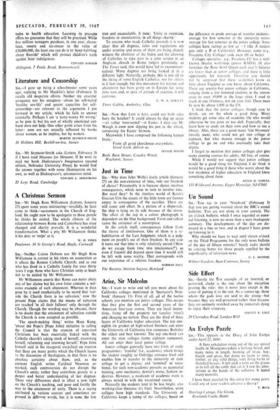Arise, Sir Malcolm
SIR,—I want to write and tell you more about the California colleges mentioned in 'Spectator's Note- book' (January 13). First of all, all of the twelve schools you mention are junior colleges. This means that they give the first and second years of the American four-year course. They are local institu- tions, living off the property tax (anglice 'rates') and charging no tuition. They are the third of three layers of California higher education. The top one- eighth (in grades) of high-school finishers can enter the University of California (ten campuses; Berkeley the oldest and best known). The top one-third can enter the state colleges (some eighteen campuses). All can enter their local junior college.
Junior colleges generally have two kinds of study programmes: 'transfer' (i.e., academic), which. brings the student roughly to Oxbridge entrance level and enables him to transfer to the university or state college to get a degree; and 'terminal' or voca- tional, for such non-academic pursuits as secretarial training, auto mechanics, dentist's nurse, fashion in- dustries. However, a modicum of academic work is always mixed in with the vocational course.
Naturally the students tend to be less bright, also working-class (because it's free). Nevertheless, some colleges have high standards. The University of California keeps a rating of the colleges, based on
the difference in grade average of transfer students: average for first semester at the university minus average for last semester at the junior college. Some collekei have ratings as low as —1 (the A student gets only a B at California). However, some (e.g., Pasadena City College) rank even (0) or better.
Colleges specialise: e.g., Pasadena CC has a well- known theatre workshop (junior RADA). (It also furnishes the Rose Bowl Queen each year!) Salaries arc lower than at senior colleges, and there is little opportunity for research. Therefore you should not he surprised that these academies know as little about England as you know about California. There are seventy-five junior colleges in California, ranging from a few hundred students in the remote areas to over 10.000 in the large cities. I used to teach in one (Ventura, not on your list). There must by now be about 1.000 in the US.
I think that the junior colleges, though easy to deride, are on the whole a good thing. Many students get some idea of academic life who would otherwise be too poor or too dull. Especially, they learn how to study on their own and how to use a library. Also, there are a good many 'late bloomers' (mostly men), who could not get into college at eighteen, but who mature enough in the junior college to go on and who eventually take their degree.
I forgot to mention that junior colleges also give many evening courses for adults. All free, of course.
While I would not suggest that junior colleges would be a good thing for England, I do think it would be a good thing if those who worry about the low incidence of higher education in England knew something about them.
ARYEII H. SAMUEL


































 Previous page
Previous page